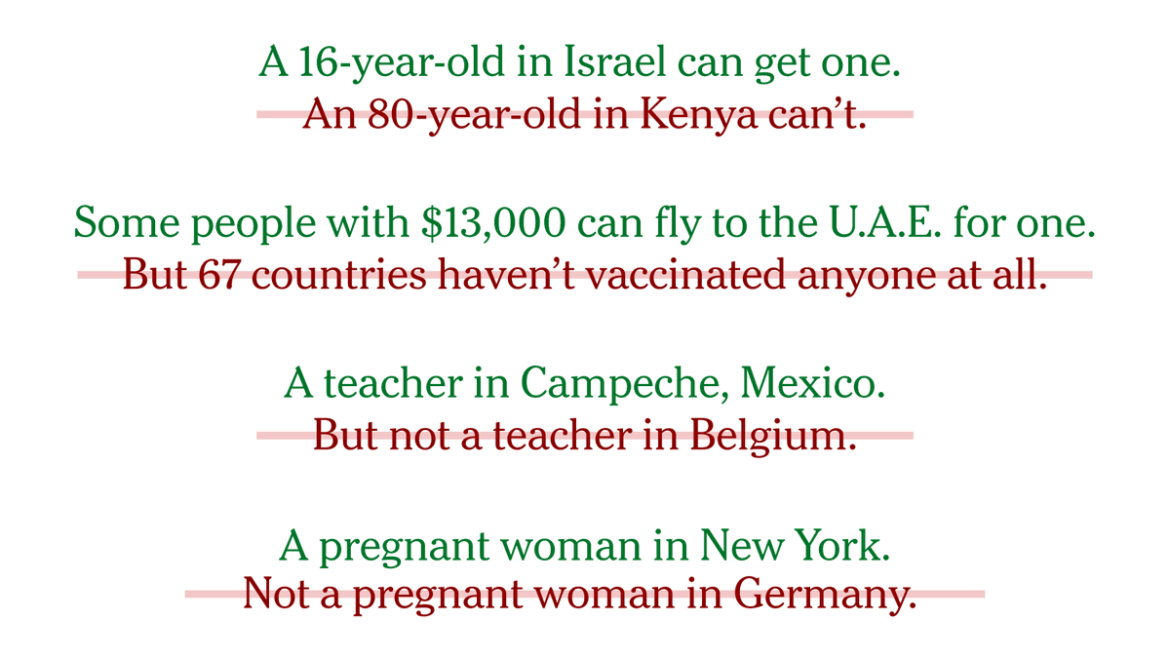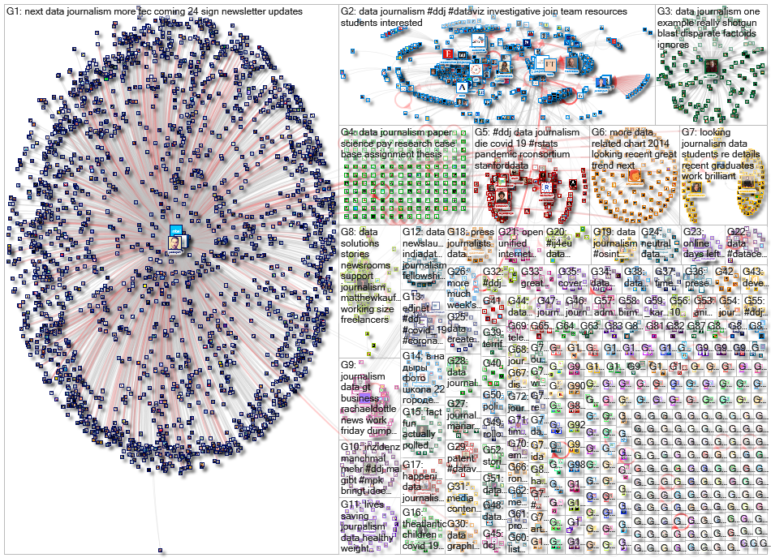 A lack of comprehensive data can seriously hinder efforts to track illicit activities. But persistent reporters will always find a way to get a glimpse of the real picture. Our NodeXL #ddj mapping from March 15 to 21, which tracks the most popular data journalism stories on Twitter, found GIJN member Oxpeckers investigating the illegal tiger trade in Europe and investigative journalist Ben Heubl offering advice on tracking unsanctioned fishing. In this edition, we also feature the Washington Post’s take on game-ending shots in college basketball, a Financial Times analysis of the nosedive of airline companies, a guide to color scales by visual storytelling ace Lisa Charlotte Rost, and a look at the burden of unpaid domestic work by data analyst Hassel Fallas.
A lack of comprehensive data can seriously hinder efforts to track illicit activities. But persistent reporters will always find a way to get a glimpse of the real picture. Our NodeXL #ddj mapping from March 15 to 21, which tracks the most popular data journalism stories on Twitter, found GIJN member Oxpeckers investigating the illegal tiger trade in Europe and investigative journalist Ben Heubl offering advice on tracking unsanctioned fishing. In this edition, we also feature the Washington Post’s take on game-ending shots in college basketball, a Financial Times analysis of the nosedive of airline companies, a guide to color scales by visual storytelling ace Lisa Charlotte Rost, and a look at the burden of unpaid domestic work by data analyst Hassel Fallas.
Buzzer-beaters
What’s more exciting than a last-second match winner? Sports fans live for these moments. In celebration of the NCAA Division I Men’s Basketball Tournament, a popular US sporting event known as March Madness, The Washington Post made a graphic with the 37 buzzer-beaters — shots that clinched a victory with no time left on the clock — over the past 40 years.
There have been 37 game-winning buzzer-beaters in the past 40 years of the NCAA tournament — half-court heaves, mid-range shots, layups and putbacks. Here are some of the most memorable from each range. https://t.co/CgA8mPHExO
— Post Sports (@PostSports) March 18, 2021
Color and Data
Color palettes play a fundamental role in visual storytelling. But choosing the right one can be tricky. Datawrapper’s Lisa Charlotte Rost wrote a four-part blog series to give an overview of the different color scales to help you decide.
I'm excited to finally share with you a four-part blog post series I've been working on in the last few months.
They all answer one question:
Which color scale should you use for which data?Part 1 gives the overview I always wished I could link to: https://t.co/lAUySvdvb3
— Lisa Charlotte Rost (@lisacrost) March 16, 2021
One in a Million
In mid-March, nearly 20 European countries put part of their COVID-19 vaccination rollouts on hold amid fears that the Oxford/AstraZeneca vaccine may be linked to blood clots. Most of them have since resumed the process after EU and British regulators said the vaccine was safe, amid arguments that the benefits of immunization outweigh any known risk. Reuters created a graphic to highlight how serious side effects are extremely rare in people who have had the jab.
AstraZeneca’s vaccine is the focus of attention because of some reports of rare blood clotting, though that does not necessarily imply causality. Here is a look at how expected and unexpected effects compare. https://t.co/13UZaF64Mb
— Reuters Graphics (@ReutersGraphics) March 19, 2021
Vaccine Inequality
More than 488 million people around the world have been vaccinated, according to The New York Times’ global tracker. But reporters also discovered that a person’s access to the vaccine is highly dependent on where they live, their age, occupation, health, connections, and general standard of living. The Times team explained vaccine inequality with this visual piece.
been thinking a lot about vaccine inequality lately — this piece is the result of working with NYT reporters across more than a dozen countries (and lots of U.S. states!) looking at who is eligible vs. who is actually being vaccinated https://t.co/rRMt8kIcFO
— Allison McCann (@atmccann) March 19, 2021
Failing the “Loyalty” Test
After World War II, the US government locked up more than 120,000 Japanese- Americans — including men, women, and children — in 10 wartime prisons because of their ethnicity. Many of the prisoners sent to the Tule Lake camp in Northern California had answered “no” to two questions on a loyalty test: Would they serve in the US military, and would they swear allegiance to the US against Japan? Some 75 years after the camp was closed, the Los Angeles Times spoke with survivors, once regarded as disloyal to the nation, who are trying to change the narrative by sharing their stories.
When I pitched a story around the 75th anniversary of the closing of Tule Lake, a WWII prison camp for "disloyal" Japanese Americans, I did not anticipate how timely it would behttps://t.co/Su27nZYEt7
— Jennifer Lu (@jenpenned) March 21, 2021
Until the Last Tiger Roars
Over the past century, the global population of wild tigers has decreased from about 100,000 to about 3,900. Although trade in this endangered species is forbidden, many of them (and when killed, their body parts) have entered the European black market. An investigation by GIJN member Oxpeckers revealed data on tigers in captivity in Italy and France, and highlighted some of the routes of illegal trade involving EU countries.
Is Europe fuelling illegal tiger trade? In our latest investigation, funded by #IJ4EU, we have exclusive data on how many tigers there are in Italy & France. Find the full investigation on #WildEye ➡️ https://t.co/zFrdXsbwNM #MediaEU #DataLeaders #ddj #IJ4EU pic.twitter.com/oMxAD289V8
— #WildEye (@WildEye_News) March 15, 2021
The Burden of Unpaid Domestic Work
During an ordinary week, people don’t usually work for more than 48 hours. But that’s if you’re not counting the cooking, cleaning, washing, running of errands, taking care of children, and other activities that most households have to do on the side. In Costa Rica women continue to bear the burden of unpaid domestic work, which consumes twice as much time for women when compared to men. Data analyst Hassel Fallas illustrated this trend in her latest article.
Por décadas, el trabajo doméstico no remunerado ha pesado -abrumadoramente- sobre los hombros de las mujeres. Aún hoy, las costarricenses destinan 2 veces más horas que los hombres a tareas del hogar y cuido. #ddj #dataviz #brechadegénero #CostaRica
🧐https://t.co/0VfqYIdUlb pic.twitter.com/PANwuGRrTT— Hassel Fallas (@HasselFallas) March 20, 2021
Tracking Illegal Fishing
West Africa has become a hot spot for large-scale fishing exploitation. This practice not only encourages piracy but can also have serious economic consequences, as well as safety concerns. Tech journalist Ben Heubl made this guide to help reporters and human rights analysts follow the trail while investigating illegal fishing and transshipment operations, which can be especially difficult to monitor when ships turn off their tracking systems.
Quick guide on how to track #illegal #fishing with #OpenData #OSINT 🤓🍾https://t.co/bQlDp4jNp8 @gijn @datajournalism
— Ben H (@benheubl) March 19, 2021
Missing Crime Data
The US government records thousands of hate crimes each year. In 2019, for example, there were 8,812 victims. But there’s a problem. Statistics gathered by the FBI are often categorized according to a single “motivation,” such as religion, sexual orientation, race/ethnicity, or gender identity. Following the Atlanta shootings, The Guardian’s Mona Chalabi argues that this data is flawed and doesn’t give the full picture; hate crimes can be motivated by more than one factor.
Atlanta shootings: why US hate crime data is so lacking | Mona Chalabi https://t.co/ZaYsl3EBVd
— Guardian Data (@GuardianData) March 20, 2021
Airlines Grounded in Debt
Airlines are hoping for a boost in global travel this summer as vaccines continue to rollout, but some of the largest companies face an uncertain future after building up more than $300bn of debt. The Financial Times analyzed their chances of recovering from the biggest crisis in aviation history.
Airlines struggle to take off in face of $300bn debt headwinds https://t.co/CHc6z2t48M
— FT Data (@ftdata) March 20, 2021
Thanks again to Marc Smith and Harald Meier of Connected Action for gathering the links and graphing them. The Top Ten #ddj list is curated weekly.
 Peter Georgiev is GIJN’s social media and engagement editor. Previously, he was part of NBC News’ investigative unit in New York. He also worked as a correspondent for Bulgarian National Television and his reporting has been published by The Guardian, Deutsche Welle, and other international outlets.
Peter Georgiev is GIJN’s social media and engagement editor. Previously, he was part of NBC News’ investigative unit in New York. He also worked as a correspondent for Bulgarian National Television and his reporting has been published by The Guardian, Deutsche Welle, and other international outlets.

